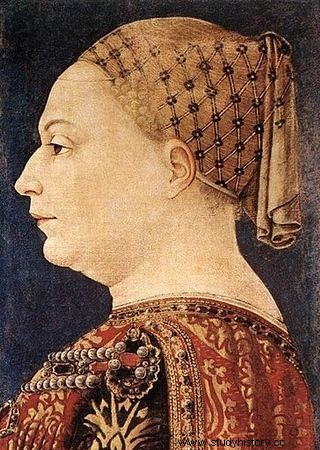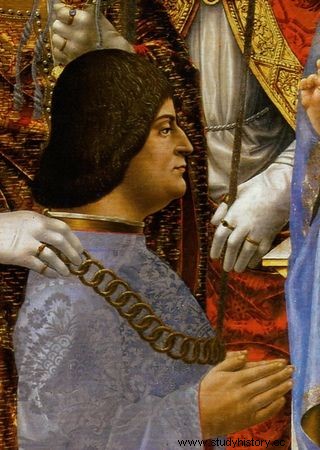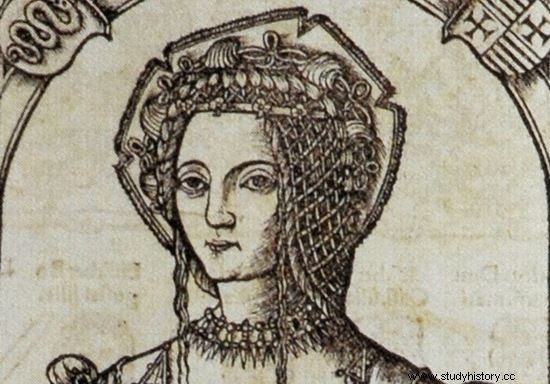strong> Fifteenth-century Italy is a land full of patrons of art, music, elegant ladies and court young men as well as talented artists. However, this idyllic image of a peninsula of beauty and artistry is just a facade. Behind it was a world of intrigue and power struggles, in which the dagger and poison became the most effective weapons
Such an environment left its mark on the characters of successive generations of Sforza, Medici, Visconti, Borgia and other eminent Italian families. The future Polish queen, Bona of the Sforza family grew up in this environment.
In the Bona family, the struggle for power was already fought by her great-grandmother and grandmother, after whom the Polish queen was named. Bianka Maria Sforza, coming from the Visconti family, resented her son's wife, Galeazzo Maria Sforza, Bona di Savoia. Perhaps the underlying cause was the stereotypical reluctance of the mother-in-law and daughter-in-law? More likely, however, it was due to a struggle for power and influence.
During Bianca Maria's journey to the place Galeazzo had designated her as a residence, the woman began to experience severe abdominal pain and then died foaming from her mouth . Was her ambitious daughter-in-law involved in this? It cannot be ruled out, after all, poison was a weapon of women.

The great-grandmother of our Polish queen Bona, Bianca Maria Sforza, took the skin of her daughter-in-law. She died in agony, poisoned.
Orphaned by the mother of Galeazzo Maria Sforza, regardless of his wife, he devoted himself to his beloved pastimes - pigeon breeding, revelry and frolics with beauties, not always according to their will. The latter drove him to the grave .
As Jerzy Besala writes in the book "Zygmunt Stary i Bona Sforza", on December 26, 1476, on the last day of his life, before going to the Galeazzo church, he tenderly embraced his seven-year-old son Gian Galeazzo, a frail, stressed, stuttering cherub, and two younger children. It was their last meeting.
On the same day, his actions on the love front took revenge on Galeazzo. The brother of the townswoman enslaved by him and two friends decided to bring Sforza to justice. His punch to the groin practically castrated the rapist and two others, shot in the back and right side, killed him.
Cherubim with the devil behind the skin
The aforementioned stuttering cherub Gian Galeazzo has now become a half-orphan. At the age of seven, he lost his father, and his mother began to pamper him indecently. Probably weak-character Gian Galeazzo could not withstand the pressure of being heir to the throne of Milan, or he was completely spoiled by Bona di Savoia's cherishing and the example of his father's rowdy life.

The man with the angelic face is Gian Galeazzo Sforza. The delicate physiognomy belonged to a man who preferred beautiful young women to his wife, and tortured his wife in anger.
Whatever the reasons, he grew up to be a weak but beautiful young man who, in the hands of ambitious relatives, became a passive puppet. The young man made no attempt to quit this role and completely surrendered himself to the power of the mother who held the regency for the time of his minority. Gian Galeazzo's springboard was found in Greek love . Although he did not despise women, he definitely preferred to invite boys to the alcove.
The young prince got under the influence of other people and finally became a puppet in the hands of his uncle, Ludovico Sforza. This, called by many il Moro (the Dark One), firmly seized the reins of government, even wiping out the power-hungry regent Bona di Savoia.
At first, he cut her off from the information and from her surroundings. Then he himself took the position of commander of the armed forces, had the former chancellor Cicco Simonetta beheaded, and he only expected Gian Galeazzo to sign letters he had written.
Soon the prince's mother had to leave Milan at the behest of her son, who was obviously controlled by il Moro. As Besala writes, the duchess fell into depression and finally resigned from regency. On November 2, 1480, Bona left for the castle of Abbiategrasso, and the next day all power was in the hands of Ludovico Sforza.
Gian Galeazzo, who quickly spent his time drinking and having sex with boys, was incapacitated by his uncle. Given his girlish beauty and weak character, this was not a challenge. Moreover, after his mother's departure, the young prince completely became mentally dependent on his uncle .
This article has more than one page. Please select another one below to continue reading.Attention! You are not on the first page of the article. If you want to read from the beginning click here.

Ludovico Sforza, a master of intrigue and a man who strove to achieve his goal by all means available.
Il Moro did not stop at taking power in Milan. His ambitions were much higher and he finalized the marriage of Gian Galeazza and Isabella of Aragonese, designed many years earlier.
Ludovico Sforza, who had secret plans to reunite the whole of Italy under his rule, needed allies, and one of them was Isabel's father, Duke of Calabria, Alphonsus.
The weddings, as befits ducal families, were boisterous, and il Moro reportedly boasted about how many times the young Sforza had fulfilled his marriage duty during the wedding night. The reality was not so colorful though.
New dynastic orders?
Gian Galeazza's possible childlessness was Ludovico on hand. The true ruler of Milan had sharpened his teeth at the dignity of a prince, so he did not force his nephew to do anything. Isabella of Aragonese had to take matters into her own hands in order to finally lose her virginity (she was actually intact after her wedding night) and try to extend the Milanese dynasty.
According to Besala, the freshly baked Duchess needed as much as a whole year, four months and 27 days to enlist Gian Galeazza into the marriage bed . Finally, the couple's first child, Francesco, was born.

Isabella of Aragonese had to go to great lengths to get Gian Galeazza to fulfill his marital duties.
The newly-baked father grew weaker and weaker (possibly as a result of giving him a slow-acting poison), and Il Moro did not stop plotting and made his own dynastic plans. When Ludovico's wife gave birth to a son, the little one began to be treated as the heir to the throne. Of course, Izabela Aragońska strongly protested against this, but instead of the expected result, she faced more insults.

Gian Galeazzo wasn't always a cute cherub. By falling into a rage, he could torture his wife to blood. It happened when his uncle sent him two beautiful young men as a gift (for a known purpose), and Izabela, irritated by this fact, decided to poison them .
When the case was released, the situation of the duchess became very unpleasant - she was attacked and harassed by both Sforza. Meanwhile, the Duke of Milan was weakening and fainting more and more.
Ippolita was born after Francescu. Shortly after her birth, her father wrote a humble letter to Il Moro, calling him his father. In it he expressed the joy of the birth of a daughter and the reproduction of our blood and our house in this way .
Duchess Isabella gave another daughter on February 2, 1494. The two older children were then in the hands of Ludovico Sforza in Milan, and the princely couple were in Vigevano. Il Moro could at any moment order the poisoning or strangling of Francesco and Ipppolitas. Izabela lived in constant fear for her children and Gian Galeazzo was fading in her eyes.

When Bona Sforza was born in 1494, nothing announced that she would become the queen of one of the largest empires in Europe at that time. However, thanks to Izabela's insistence, it just happened.
When the newborn girl was named after her paternal grandmother, no one expected her fate to be tied to a distant country on Vistula for many years. Little Bona Sforza may not have survived her childhood, or at some point may have become an uncomfortable pawn in dynastic chess, removed with poison or a dagger. Instead, she grew up and became a seasoned gamer herself.
Source:
- Jerzy Besala, Zygmunt Stary and Bona Sforza, Zysk i S-ka Publishing House, Poznań 2012.
